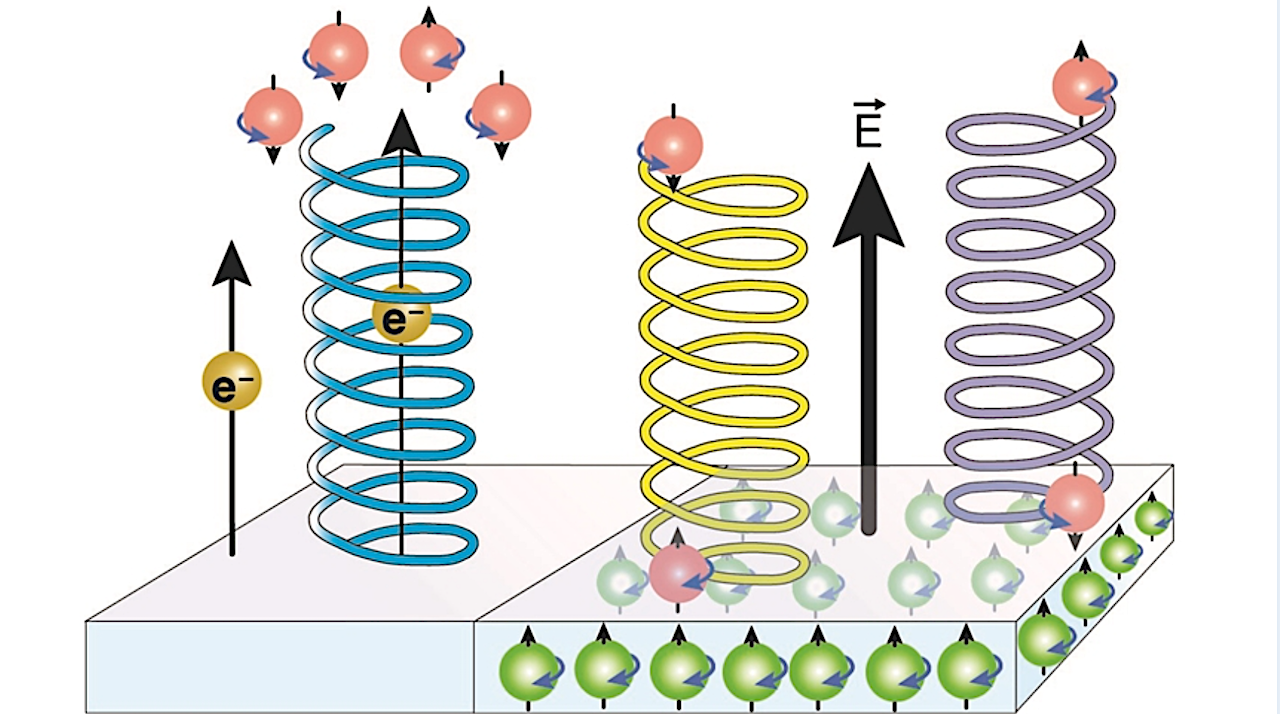This is how the chirality-induced spin selectivity (CISS effect) demonstrates itself: Electrons (e– or red and green spheres with arrows indicating electron spin, either up or down) with the “incorrect” rotation direction (spin) are restricted or sieved out while tunneling through spiral molecules, contingent on the spirals’ handedness (left- or right-handed). Consequently, a particular electron spin type predominates (electrons with the downward-pointing arrow on the left side). The electric field of a metallic surface (E, pointing upwards, right side) displaces the electrons in the bound heptahelical molecules, causing them to accumulate slightly in the lower part of the molecule near the surface. In the scenario of chiral molecules, electrons with different spins are also displaced differentially based on the molecule’s handedness. Consequently, the molecule becomes “spin-polarized” and acquires magnetic properties. Thus, depending on the metallic surface’s magnetization direction, chiral molecules interact with varying degrees. In this instance, the purple spiral binds more strongly to the surface than the yellow one, as opposite spins exhibit an “attraction” effect (the red and green electrons with different spins positioned atop each other). Graphic: Empa
The concept of homochirality in life, where all biomolecules in living organisms exist solely in one of two mirror-image forms, has intrigued numerous scientific luminaries, from Louis Pasteur, the discoverer of molecular chirality, to William Thomson (Lord Kelvin), and Nobel Prize laureate Pierre Curie.
A definitive explanation is still elusive, given that both forms possess similar chemical stability and do not differ significantly in their physico-chemical attributes. The hypothesis suggesting that the interplay between electric and magnetic fields could elucidate the preference for a specific mirror-image form of a molecule, known as enantiomers, emerged early on.
Only recently did the first indirect evidence surface, indicating that the combination of these force fields can indeed differentiate between the two mirror images of a molecule. This revelation stemmed from the examination of chiral molecules’ interaction with metallic surfaces exhibiting a potent electric field over short distances.
Magnetic metals’ surfaces like iron, cobalt, or nickel enable diverse combinations of electric and magnetic fields, where the magnetization direction can be reversed from “North up – South down” to “South up – North down.” If the interplay between magnetism and electric fields triggers “enantioselective” effects, the interaction strength between chiral molecules and magnetic surfaces should vary based on whether a right-handed or left-handed molecule settles on the surface.
Opposing magnetic fields attract mirror images
Indeed, a team of researchers led by Karl-Heinz Ernst from Empa’s Surface Science and Coating Technologies lab and colleagues at the Peter Grünberg Institute at the Forschungszentrum Jülich in Germany recently disclosed in the scientific journal Advanced Materials that this is the case.
The team coated a (non-magnetic) copper surface with small, ultra-thin magnetic cobalt “islands” and determined the magnetic field direction in these islands using spin-polarized scanning tunneling microscopy. They then deposited spiral-shaped chiral molecules – a 1:1 mix of left- and right-handed heptahelicene molecules – onto these cobalt islands in ultrahigh vacuum.
Subsequently, by employing scanning tunneling microscopy, they tallied the number of right- and left-handed helicene molecules on the differently magnetized cobalt islands, totaling nearly 800 molecules. The results revealed that depending on the magnetic field direction, one form of the helicene spirals preferred settling over the other (as depicted on the right side of the graphic).
Furthermore, the experiments unveiled that the selection – the inclination towards one enantiomer over the other – occurs not only during binding on the cobalt islands but even before. Prior to assuming their final (preferred) position on a cobalt island, the molecules traverse long distances across the copper surface in a considerably weaker bound precursor state in search of an optimal location.
These molecules are solely tethered to the surface by van der Waals forces, which arise from fluctuations in the electronic shell of atoms and molecules, hence being relatively feeble. The revelation that even these forces are influenced by magnetism, specifically the electrons’ spin direction, was previously unknown.
